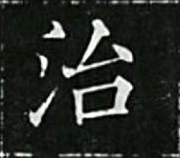Governing a large country is like steaming small fish.
— Laozi in Daodejing, 60, translated by Edmund Ryden

Character taken from a rubbing of an inscription by Tang official Ouyang Xun 欧阳询 (557–641)
Source: Sina
A dictionary of the second century AD refers to the character 治 as the name of a river in Shandong province, but puts forward no explanation for how it came to mean ‘control’, ‘bring order’, ‘govern’. The common use of this character in reference to the legendary sage ruler Yu 大禹 (c. 2200–2101 BCE), who ‘regulated’ the waters of China in an ancient time of great floods, suggests that it derives from the act of controlling water. While this ostensibly explains why the radical (the graphical component of the character that may, but doesn’t always, have some connection to the character’s meaning) of 治 is the water radical 氵, the evidence is far from solid. By the Spring and Autumn period (eighth to fifth century BC), the character 治 commonly appeared in one graphic form or another in political discourse and has done so ever since.
Curiously, the character’s supposed antonym, luan 亂, in very early texts is sometimes used to mean ‘bring order’, and given the gloss 治. The scholar Yang Shuda (1885–1956) explained that the character now read luan originally depicted two hands, one holding silk while the other spooled it — suggesting the bringing of order to a possible tangle. Yet this understanding of the character describes an act with the potential for both order and chaos. This is, perhaps, preserved in the rare character 乿, once an alternative way of writing 亂, and now read zhi or luan — that is having the meaning of either order or chaos depending on how it is read, which is probably why the character is little used. The origin of the character 治 as ‘control’ may thus be as homonym, graphic variant or some form of cognate (as suggested by a dictionary of the eleventh century AD).


